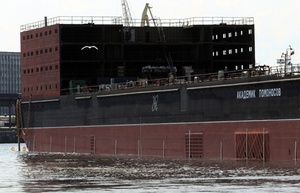
New Managing Director for Bellona Norway
The Board of the Bellona Foundation has appointed former Minister of Climate and the Environment Sveinung Rotevatn as Managing Director of Bellona No...
News

Publish date: August 26, 2015
Written by: Charles Digges
News
Russia’s state nuclear corporation Rosatom has announced it will launch another floating nuclear power plant produced in 40 percent less time than the one currently under construction in St. Petersburg, and without some of the trimmings that have protracted its construction, Russian media reported.
Sergei Zavyalov, deputy director of construction for FNPPs at Russia’s nuclear utility Rosenergoatom, said from St. Petersburg that a second FNPP will be built by 2030, RIA Novosti reported.
Russia’s first FNPP, the Akademik Lomonosov, is still under construction at the city’s Baltic Shipyard, and apparently scheduled for an already delayed delivery date of next year, though unnamed Rosatom officials have privately said even that is unlikely.
 The Akademik Lomonosov puts in for further construction at the Baltic Shipyard. (Photo: Baltiisky Zavod).
The Akademik Lomonosov puts in for further construction at the Baltic Shipyard. (Photo: Baltiisky Zavod).
Rosatom meanwhile announced it will begin training the 78 crewmembers and technicians that will staff the first FNPP in September, according to RIA Novosti. Their training is expected to take two years, said Tayr Tayrov, Rosatom’s director of educational programs.
According to a report in the Russian business broadsheet Kommersant, sources within Rosatom have said the current construction of the Akademik Lomonosov has been “very expensive,” and that the state nuclear company will switch to more “compact” models that eliminate on-vessel storage for spent nuclear fuel, and shed living quarters for the crew.
The sources did not say how spent nuclear fuel from this smaller design would be stored or handled, and offered no information on how crews would be accommodated.
At the same time, Zavyalov said the Akademik Lomonosov, once delivered to the Kamchatka Peninsula port of Pevek, would substitute for power produced by the Far Eastern Chukotka region’s Bilibino Nuclear Power Plant, and the region’s Chaunsk Theromoelectric plant, said RIA Novosti.
The anonymous sources told Kommersant that using the FNPP as the only source of power in the region was ill advised.
 Nuclear reactor installation on the Akademik Lomonosov. (Photo: Baltiisky Zavod)
Nuclear reactor installation on the Akademik Lomonosov. (Photo: Baltiisky Zavod)
The case that unnamed Rosatom officials made to Kommersant for making smaller FNPPs is based on the “experimental nature” of the Akademik Lomonosov.
In some contradiction to the RIA Novosti report, the anonymous officials said the first FNPP’s delivery date and budget remain “fluid.”
The sources put the delivery date of the Akademik Lomonosov closer to 2019 – three years later than scheduled.
Smaller FNPPs on the drawing board
Zavyalov confirmed to both news outlets that Rosatom was considering principle changes in its future FNPP production.
“The FNPP currently under construction is an experimental reference model – in the future such metal-intensive equipment will not suit us, it’s too expensive,” Kommersant quoted him as saying.
He said Rosenergoatom would “optimize technical decisions, create installations a few times smaller in water displacement, decline a number of features, for instance on board spent nuclear fuel storage, crew living quarter, and build hardware exclusively for electricity production.”
The power range of these new, stripped down FNPPs, Zavyalov told the paper, would be in the 200-500 megawatt range, far outpacing the 70 megwatt capacity of the Akademik Lomonosov’s two reactors.
 A mock up of the Akademik Lomonosova in Port. (Photo: http://www.okbm.nnov.ru/russian/lomonosov)
A mock up of the Akademik Lomonosova in Port. (Photo: http://www.okbm.nnov.ru/russian/lomonosov)
A source within Rosenergoatom told the paper new reactors would have to designed to meet this capacity.
Zavyalov estimated the time to build the new compact FNPPs would be reduced by 40 percent of the time it’s taken to deliver on the Akademik Lomonosov. He said the smaller models could be produced “essentially conveyor belt style.”
The Akademik Lomonosov’s dragging history
The Akademik Lomonosov has been plagued since the beginning of construction in 2006 by upwardly spiraling costs, and even a change of shipyard.
Its construction was initially begun at Sevmash in Northwest Russia, but in 2009 was moved to the Baltic Shipyard amid whispers that money was being siphoned off the project to complete Sevmash’s defense contracts.
In St. Petersburg, the FNPP’s fate became ensnared in bankruptcy proceedings against the Baltic Shipyard. Russian United Shipbuilding Corporation bought up the shipyard in May 2011, and the build continued.
Rosatom told Kommersant that the rocky history of trying to get the Akademik Lomonsov on the water is a result of the vessel being, again, “experimental.”
Kommersant’s anonymous sources at Rosatom told the paper to realistically expect the Akademik Lomonosov’s plug-in to the grid at Pevek in around 2021. Zavyalov said the FNPP is 70 percent complete, a progress report that has been advertised before.
Nataliya Malisheva, development director and editor of the nautical news portal Portnews.ru told Kommersant that she expected the completion of the Akademik Lomonosov will require yet further investment from Rosatom, which could upset investment in building further floating plants.
Zavyalov said that the fuel cycle of the Akademik Lomonosov’s reactors would last for 10 years once it begins operations in Kamchatka.
“Because of that, during this time we will definitely build a second [floating nuclear power plant],” RIA Novosti quoted him as saying.

The Board of the Bellona Foundation has appointed former Minister of Climate and the Environment Sveinung Rotevatn as Managing Director of Bellona No...

Økokrim, Norway’s authority for investigating and prosecuting economic and environmental crime, has imposed a record fine on Equinor following a comp...

Our op-ed originally appeared in The Moscow Times. For more than three decades, Russia has been burdened with the remains of the Soviet ...

The United Nation’s COP30 global climate negotiations in Belém, Brazil ended this weekend with a watered-down resolution that failed to halt deforest...